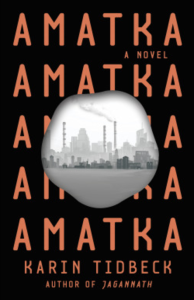August is Women in Translation Month (#WITMonth), so I’m only reviewing books by women in translation.
Vanja emptied a box of pencils, lined them up on the shelf, amd pointed at them one by one. ‘Pencil, pencil, pencil.’
It wasn’t long before the words flowed together. ‘Pencil-pencil-pencil-pen-cilpen-cilpen- cilpen-cilpen-cilpen–‘
The last pencil in the row shuddered. As Vanja bent closer to look, the shiny yellow surface whitened and buckled. Then, suddenly and soundlessly, it collapsed into a pencil-shaped strip of gloop.
 At first, Karin Tidbeck’s Amatka seems like your standard Soviet-inspired dystopia. Its characters call each other “comrade”, they must always put the community before the individual, and the expression of heterodox views may get one reported. Women who don’t reproduce by a certain age are frowned upon (though homosexuality is accepted), children are raised separately from their parents, and the tiniest thing generates tons of paperwork. Except–little by little, it becomes clear that the world of Amatka, at first glance so familiar, is in fact profoundly strange. Why is everyone vegan? Why does everyone has eczema? Why is the main character’s job so important, when all she’s doing is investigating skin care product usage? And most importantly–why do the people of Amatka have to regularly recite the names of the inanimate objects and buildings that surround them? and why do these inanimate object and buildings start to “shudder” when ignored for too long, even occasionally turning into gloop?
At first, Karin Tidbeck’s Amatka seems like your standard Soviet-inspired dystopia. Its characters call each other “comrade”, they must always put the community before the individual, and the expression of heterodox views may get one reported. Women who don’t reproduce by a certain age are frowned upon (though homosexuality is accepted), children are raised separately from their parents, and the tiniest thing generates tons of paperwork. Except–little by little, it becomes clear that the world of Amatka, at first glance so familiar, is in fact profoundly strange. Why is everyone vegan? Why does everyone has eczema? Why is the main character’s job so important, when all she’s doing is investigating skin care product usage? And most importantly–why do the people of Amatka have to regularly recite the names of the inanimate objects and buildings that surround them? and why do these inanimate object and buildings start to “shudder” when ignored for too long, even occasionally turning into gloop?

The gorgeous Spanish edition.
This is the sort of worldbuilding I love: the kind where very little is explicitly explained, encouraging the reader to play detective and figure things out by themselves. And there are enough clues that you can figure most of it out. In fact–precisely because piecing things together yourself is such a key aspect of enjoying Amatka, I’m going to keep my review short, and reveal as little as possible about the book’s contents. I will say, though, that this is a book that belongs on the same shelf as China Mieville’s Embassytown and Max Barry’s Lexicon: it’s speculative fiction that shines a light on language, and the way language can shape the very fabric of reality. It’s also one of those books that lends itself to a bunch of possible readings, some of which I find particularly exciting and which I’m exercising a crazy amount of self-control not to talk about here, because, again, I want you to read this book and come up with your own readings, and/or get back to me when you’re finished so we can talk about it without fear of spoilers.
And, as ever, Tidbeck’s prose–translated by herself from the original Swedish–is an absolute pleasure to read. She is particularly good at conveying the materiality of Amatka’s world–it’s easy to picture the spaces her characters move in, sometimes even to feel them (“the upholstery looked slippery but felt unpleasantly rough to the touch”)–which makes it particularly disconcerting whenever a piece of Amatka’s world starts trembling and threatening to turn into gloop. But beyond that, Tidbeck has such a nice, solid, clear way of writing that I would have happily read Amatka even if it had turned out to be a completely unoriginal and derivative Soviet-inspired dystopia–though I suspect every fibre of Tidbeck being’s would prevent her from ever writing something that can be labelled unoriginal.
Read this book!
Advertisements Share this:




